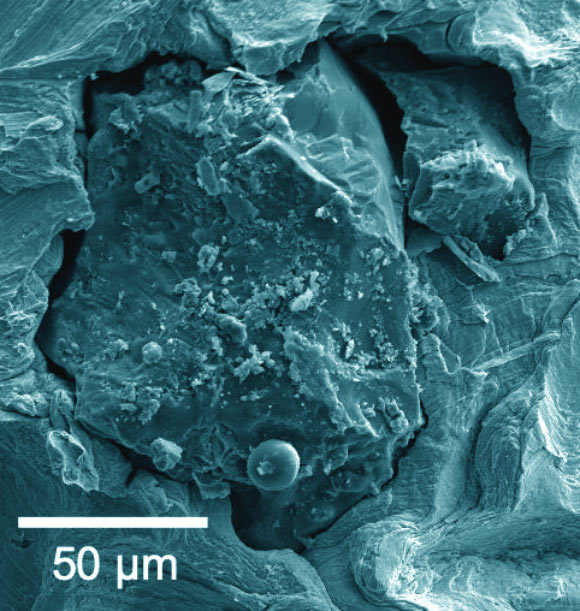An international team of planetary scientists and geochemists from the United States and Switzerland has demonstrated that a technique called atom probe tomography can be successfully used to characterize the composition and texture of single grains of lunar dust at near-atomic resolution.

A tiny grain of lunar soil brought back by Apollo 17, magnified under a scanning electron microscope. Image credit: Jennika Greer, Field Museum.
Atom probe tomography is normally used by materials scientists working to improve industrial processes like making steel and nanowires.
But its ability to analyze tiny amounts of materials makes it a good candidate for studying lunar samples.
“We’re analyzing rocks from space, atom by atom,” said Jennika Greer, a Ph.D. student at the Field Museum and the University of Chicago.
“It’s the first time a lunar sample has been studied like this. We’re using a technique many geologists haven’t even heard of.”
“We can apply this technique to samples no one has studied,” said Dr. Philipp Heck, also from the Field Museum and the University of Chicago.
“You’re almost guaranteed to find something new or unexpected. This technique has such high sensitivity and resolution, you find things you wouldn’t find otherwise and only use up a small bit of the sample.”
For the analysis, the researchers used one single grain of lunar soil from the Apollo 17 samples.
They identified products of space weathering, pure iron, water and helium, that formed through the interactions of lunar soil with the space environment.
Extracting these precious resources from lunar soil could help future astronauts sustain their activities on the Moon.
To study the tiny grain, the scientists used a focused beam of charged atoms to carve a tiny, super-sharp tip into its surface.
This tip was only a few hundred atoms wide — for comparison, a sheet of paper is hundreds of thousands of atoms thick.
“We can use the expression nanocarpentry. Like a carpenter shapes wood, we do it at the nanoscale to minerals,” Dr. Heck said.
Once the sample was inside the atom probe, the study authors zapped it with a laser to knock atoms off one by one.
As the atoms flew off the sample, they struck a detector plate. Heavier elements, like iron, take longer to reach the detector than lighter elements, like hydrogen.
By measuring the time between the laser firing and the atom striking the detector, the instrument is able to determine the type of atom at that position and its charge.
Finally, the researchers reconstructed the data in three dimensions, using a color-coded point for each atom and molecule to make a nanoscale 3D map of lunar dust.
They encourage other scientists to try this technique out.
“It’s great for comprehensively characterizing small volumes of precious samples,” Greer said.
“We have these really exciting missions like Hayabusa-2 and OSIRIS-REx returning to Earth soon — uncrewed spacecrafts collecting tiny pieces of asteroids.”
“This is a technique that should definitely be applied to what they bring back because it uses so little material but provides so much information.”
The results are published in the journal Meteoritics & Planetary Science.
_____
Jennika Greer et al. Atom probe tomography of space-weathered lunar ilmenite grain surfaces. Meteoritics & Planetary Science, published online February 6, 2020; doi: 10.1111/maps.13443







